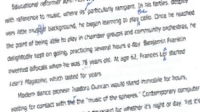If you study most of the
copywriting courses promoted online, you'll
get the impression that what works - and
what copywriting clients want - is weird,
shocking headlines, hype upon hype,
exaggerated promises and a carnival-barker
tone. For example, one course holds up these
headlines as models to emulate:
-
Heads Up! Your fate is
in the hands of drunks, drug addicts,
blackmailers, and imbeciles.
-
Profit With the
Insiders Without Breaking a Single Law
-
A Rare Opportunity to
Turn $5,000 into $3.52 Million
-
Medically Proven
Miracles of Healing - Let me tell you
about the stunning, no-side-effects
cures that greedy drug companies and FDA
bureaucrats don't want you to have.
For business-to-business
(b-to-b) copywriting clients, however, this
in-your-face style of writing does not
succeed. It does not appeal to them, and it
is not what they want their copywriters to
write for them. You may argue all you like
that response numbers prove it's more
effective, but most don't care about your
numbers in the least.
 |
Improve Your
Proofreading
Quick online course teaches how to
catch pesky typos. Whether you check
writing on screen or on paper, learn the
stakes for error-ridden copy, the five
best proofreading methods and the tools
you can or shouldn't use to identify
errors. Includes practice tests and
answers.
Proofreading Hacks course. |
Instead, b-to-b clients
want something punchy, clear,
attention-getting and direct. Most of all,
they want you to be able to come at their
business with the clear-eyed perception and
skill to uncover the true value they offer
their clients and to present that
effectively and persuasively.
Business-to-business
companies are often steeped in jargon, and
you'll need to be able to decipher their
jargon so you can explain what they're up
to, why it matters and how they differ from
competitors apart from their jargon.
Sometimes they cling to their jargon as if
it's a safety blanket, but they rarely
object when you keep the jargon in for those
in the know and provide wording that clues
in those who may not be as hip to the jargon
as your client thinks they are.
It's also helpful if you
are really skilled in figuring out the
benefits of features. B-to-b clients are
often stuck in pitching only features and
aren't using the power of combining features
and benefits. Features, as you probably
know, are the "what" of offerings and
benefits are the "so what."
In b-to-b copywriting,
tone is crucial. B-to-b clients expect and
are most comfortable with a professional
tone. If you get really creative in a way
that includes a sarcastic, bombastic,
hysterical, insulting, scapegoating,
accusatory or heavy-handed tone, you'll most
likely have an uphill battle getting the
client to approve your copy. If you get
really creative in a way that's consistent
with a business-like tone, they may think
you're a genius and most likely will have no
problem with it.
For example, here are some
email subject lines created for b-to-b
clients:
-
Whoever Heard of 7,701
Phone Calls From a Single Jingle?
-
Take Command of Your
Email Inbox.
-
Can Your Latest
Release Pass the Trampoline Test?
-
Pssst, Your Signage Is
Outdated.
Again, tone is crucial.
These subject lines are dramatic and
unexpected, but they're not outrageous,
over-the-top or offensive in any way.
They're quite different from the headlines I
quoted at the outset. They are not
embarrassingly outside the pale of
mainstream business culture.
In the b-to-b world, a
client's comfort zone is extremely relevant.
They need to feel that your copy represents
them well, and they may delightedly use your
services again and again for the sole reason
that they are so pleased with how well
you've captured what they're all about. Have
that as your aim, and you'll easily attract
b-to-b clients and receive repeat
assignments from many of them for years.






